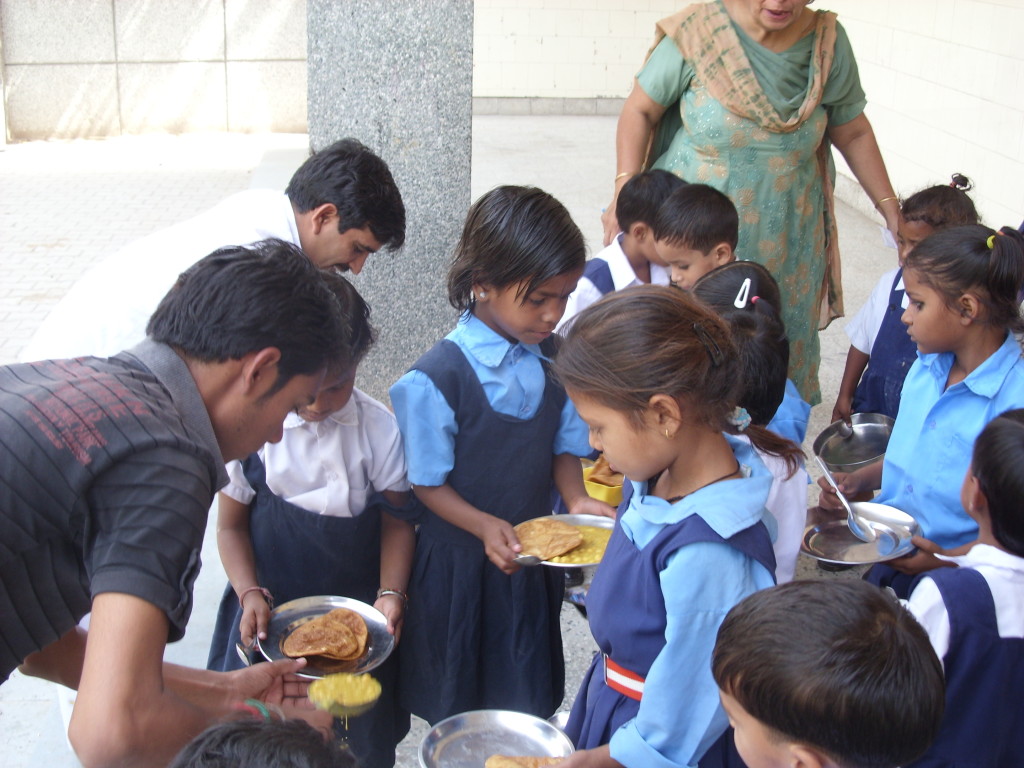Midday Meal scheme is a nationwide program to improve nutritional status of children in schools. Under this scheme, children in primary and upper primary classes are supported by midday meals in schools and education centers. Currently it is serving over 120,000,000 children all over the country.
The government of India has introduced a number of steps for effective implementation of this scheme. Food prepared for children in schools is tasted by at least 2 to 3 people including a teacher. This will ensure the quality and hygiene of served food. Schools are allotted safe storage facilities. Ingredients used in the preparation are of certified quality, which is accredited by laboratories. The cooking cost has been altered with a grand of 7.5% increase in previous cost. Social audition of this scheme is expected to start soon.
According to aresearch, girls are more likely to receive the benefits of this program. Also, the emphasis is more on children in rural India. The program participants are more likely to have a higher family dependency ratio. According to the current structure, the more children a family has, the more will be the participation. This indicates a factor of family dependency ratio in this scheme. The participation is also affected by the literacy level of parents.
While Mid Day Meal program runs across India, serving children in more than 1.2 million government schools, it has improved nutrition considerably. This has increased attendance of school students. However, there are a number of serious issues surrounding the scheme. Contamination is one of them. According to experts, lack of concrete organizational structure is the root cause of its problems. Additionally, lack of an agile monitoring mechanism is another complication. The Scheme was adopted on the basis of the Madras Municipal Corporation School Launch Scheme with no definite structure to implement. In majority of schools, the school management or administration is entitled to use the fund, while the lack of monitoring mechanism has depreciated this service.
Sponsored by the Central Government under the direction of Supreme Court, this programis run jointly by state and central government. The shortcomings of this program indicate that there is some serious lack of basic understanding of the implementation of cores aspects as well as in the methods of evaluation of cost. The cost structure needs to be revisited in order to make this scheme more effective. This includes the cost involved in raw material, transportation and in human resources. Since, in return, allocated funds eventually affect the quality of food provided this is the pivotal aspect that needs to be targeted.
This scheme is implemented in two widely accepted models as decentralized and centralized modes. The decentralized model is implemented by collaborating with self help groups and local helpers. Here, meals are cooked in schools where local cuisines are served. In this system, teachers or the school administration monitors the program, while the funds are being dispersed by the government. Few shortcomings, such as shortage and utensils or adequate infrastructure have been the major concerns of this model. Also, it is reported that in 2004, 87 children died due to an accident of fire breakout in a school.
In centralized model, PPP or Public Private Partnership is administered. This model is more prevalent in urban areas. Being a viable option in these areas, it has been implemented with aids from NGO’s. However, even in this system quality is being inconsistent. Surveys have found out that the supply of food is inadequate in most of the cases and there is a huge communication gap. Taxation and compliances has been the major issues in this system.
The taxation system should undergo basic change of structure. At the decentralized model, there are no taxation formalities. In contrast, in the centralized model, the taxation is per every required formality. The difference of cost and expense is quite high in this model. According to survey, an agency implementing MDMP getsRs. 3.59 for a child. The amount is again dissipatedin different taxation heads as service tax, VAT, Excise, Road Tax and also Customs duty. Entry tax is levied on machinery brought from other states. Tax for professional workers is also being levied. Thesebeing the major hurdlestowards a cost effective implementation, the Government should take initiatives to eliminate Taxes in this particular sector. This will create enthusiasm in NGO’s and private undertakings to contribute better to the cause.


